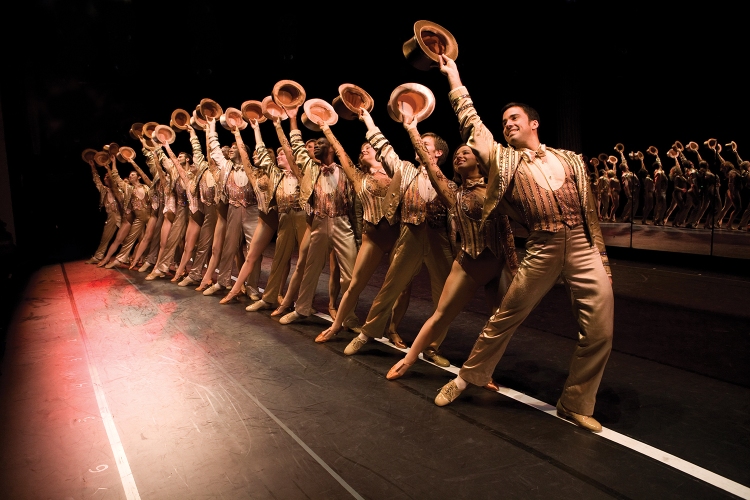
A Chorus Line has had a certain allure to me since my grandmother complained about seeing a local production of it in her hometown. She hated it, deploring the foul language and sexual subject matter. Naturally I assumed it was right up my alley.
I was thrilled to see that the Ordway would be including it in their season this year and I’ve been looking forward it for quite some time. This show does something I haven’t seen onstage before – creating a love story focused on those who are usually overlooked in a performance, those who are not cast as leads but in the chorus. Through the stories of these performers, A Chorus Line weaves a stunning, touching tale of what people do for their work and their love of art, specifically dance.
Set in the midst of an audition to find four male and four female dancers, twenty-four hopeful dances dancers – cut down to seventeen at the top of the show – share their stories of finding dance as they are called upon by the director, Zach (Tom Berklund). Focusing on what called people to dance, whether it’s escaping a poor family life and yearning to have beautiful (“At the Ballet”) or because their family danced and they enjoyed it (“I Can Do That”), the characters are literally fleshed out through their physicality and movement.
There are moments of utter frankness in language and body that are apparently still shocking to some people (including the very uncomfortable couple sitting next to me that left early). But this show is so much more than its language or portrayal of sexuality, though that is central to the story lines of several of the characters. It is, however, focused on the body and the physical aspects of performance as well as the mental aspects. It’s easy to forget how much theater physically demands of its performers and this show reminds of it at every moment. It especially highlights the more superficial aspects and how they hurt their performers through typecasting and focusing on what a dancer looks like. In “Dance: Ten, Looks: Three” Val (Maria Briggs) humorously and bitingly explains how she couldn’t get cast in any show until she had plastic surgery. Her flaunting of her new body and her attempts to convince how easy it is to obtain – “just go out in buy it” stand in stark contrast to the stories of those who use dance to feel better about their bodies, especially Paul (Omar Garibay) who’s story of using dance to come to terms with his sexuality is touching and powerful.
In the end, the story of Cassie (Molly Tynes), a lead dancer who went to Hollywood only to find she couldn’t get any work and has returned to audition for chorus, is one of the most powerful. Questioned by Zach how she could possibly return to the chorus, Cassie responds that she would be proud and honored to be in the chorus. Zach is confused and asks “Don’t you want to be special?” To which Cassie retorts that each and every person in the chorus is special. They all have their own story and their own style and, while they come together and dance the same, they all have their own unique character. By the end of the audition, with each character struggling to figure out what they will do when they can no longer dance, they in some ways decided it doesn’t matter – what does matter is that they had this opportunity to do “what they did for love,” for the love of dance, and that they don’t regret it.
There are aspects of the show that feel a bit dated and some of the characters sound a bit cliched, but by the end, an array of complexity and the uniqueness that Cassie cherishes is realized. In some ways, this show is now a period piece, providing a look at what it was like working Broadway in the 1970s. In other ways – the anxiety around auditioning, the desperate need to get work, the worries of what Broadway theater are becoming – are timely.
The Ordway’s staging is clever and somewhat immersive, stationing Zach at an audition table in the front of the mezzanine section of the theater (the upper level of the main orchestra area). As he goes back and forth between the stage and the table, it’s almost as if the audience isn’t there and an actual audition is taking place. Taken into this staging is a way of showing love to other unsung voices in theater who are overlooked just as much as the chorus. The lighting in this show is incredible and the costuming manages to capture each character’s personality while still keeping inside the bounds of dance audition gear. The orchestrations are gorgeous and the pit, led by Raymond Berg, sound phenomenal. And while there isn’t much of a set, the set pieces of mirrors that are used add a wonderful compliment and glamour to the performance. And of course there’s choreography – something that even I am guilty of overlooking in performances. This show makes you pay attention to choreography as it’s all about it – the dance, how the body moves, and how people can be characterized by movement.
What’s best about this show is that you don’t have to be a member of the theater community to love and understand what it’s about. It it especially easy for artists to relate to but even those who took dance in their childhood, have ever interviewed for their dream job, struggled to understand their bodies in their teenage years, or had issues with a teacher in a field they loved will appreciated this show. And if you did take dance in your youth, it’ll make you wish you’d never stopped.
A Chorus Line is playing now through February 28 at the Ordway Theater. Ticket information and the show schedule can be found on the Ordway’s website.